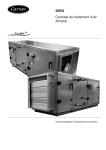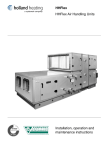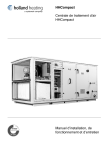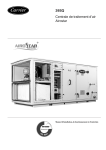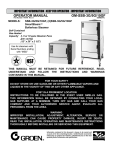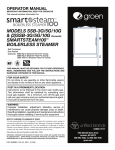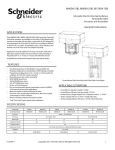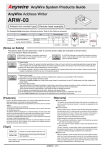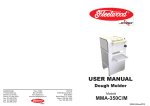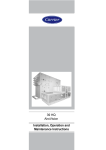Download Carrier 39E Operating instructions
Transcript
39 HQ Airovision Air Handling Units Installation, operation and maintenance instructions CONTENTS 1 - SAFETY CONSIDERATIONS ...............................................................................................................4 1.1 1.2 1.3 1.4 - 2 - TRANSPORT AND LIFTING INSTRUCTIONS ..................................................................................5 2.1 2.2 2.3 2.4 2.5 - 3 - CHECKLIST OF START-UP CHECK POINTS....................................................................................7 3.1 - Checklist of start-up check points ....................................………………………………………………………………7 4 - START-UP INSTRUCTIONS .................................................................................................................9 4.1 4.11 4.12 4.13 - Casing...........................................................................…………………………………………………………………9 4.1.1 - Casing panels .................................................……………………………………………………………………9 4.1.2 - Doors and access covers ............................................……………………………………………………………9 4.1.3 - Flexible connections ....................................…………………………………………………………………...…9 4.1.4 - Earthing .........................................................................................................................................................9 4.1.5 - AHU installation and connection .............................……………………………………………………………9 - Dampers ............................................................................……………………………………………………………10 - Air filters...........................................................................................…………………………………………………10 - Heaters ......................................................................………………………………………………………………….10 4.4.1 - General ...........................................................………………………………………………………………….10 4.4.2 - Electric heaters ..................................................................…………………………….………………………10 4.4.3 - Steam heaters ..........................................................……………………………………………………………10 - Coolers....................................................................................................................................................................11 - Heat recovery wheel ..................................................…………………………………………………………………..11 - Plate heat exchanger .......................................................………………………………………………………………11 - Direct steam humidification ..........................................................……………………………………………………11 - Electrical steam humidification ...........................................................……………………………………………….12 - Water humidifiers ......................................................................………………………………………………………12 4.10.1 - Spray humidifier ...........................................................………………………………………………………12 4.10.2 - Infrasonic humidifier...........................…………………………………………………………………………12 - Fan..........................................................................……………………………………………………………………12 - Sound attenuator................................................................……………………………………………………………13 - Lighting ..................................................................……………………………………………………………………13 5 - MAINTENANCE PLAN .......................................................................................................................14 5.1 - Checklist of check points and maintenance intervals .............…………………………………………………………14 4.2 4.3 4.4 4.5 4.6 4.7 4.8 4.9 4.10 General .....................................................................................................................................................................4 Applications..............................................................................................................................................................4 Instruction types .......................................................................................................................................................4 Disposal of parts/materials .......................................................................................................................................5 General ....................................................................…………….………………………………………………………5 Transport and storage .................................................................………………………………………………………5 Transport protection .......................................................................……………………………………………………6 Vertical transport ......................................................................………………………………………………………..6 Horizontal transport ........................................................………………………………………………………………6 CONTENTS (continued) 6 - MAINTENANCE AND OPERATING INSTRUCTIONS....................................................................16 6.1 6.2 - General ...................................................................……………………………………………………………………16 - Casing panels .........................................................…………………………………………………………………….16 6.2.1 - Inside installation ....................................................……………………………………………………………16 6.2.2 - Outside installation ..................................................…………………………………………………………...16 - Doors and access covers.........................................................…………………………………………………………16 - Flexible connections ..................................................……………………….…………………………………………16 - Earthing ..................................................................……………………………………………………………………16 - Dampers ................................................................................…………………………………………………………16 - Outside air intake...................................................................…………………………………………………………16 - Filters .........................................................................…………………………………………………………………16 - Heaters ...........................................................................………………………………………………………………16 6.9.1 - Water, glycol and steam coils............................................................................………………………………16 6.9.2 - Electric heaters ......................................................................…………………………………………………17 - Coolers....................................................................……………………………………………………………………17 - Heat recovery wheel........................................................………………………………………………………………17 - Plate heat exchanger...............................................................…………………………………………………………17 - Water humidification....................................................................…….………………………………………………17 6.13.1 - Steam humidification ..............................................…………………………………………………………..17 6.13.2 - Spray humidifier ....................................................……………………………………………………………17 6.13.3 - Infrasonic humidifier ............................................…………………………………………………………….18 - Fan.........................................................................…………………………………………………………………….18 6.14.1 - General.......................................................................................................................................................18 6.14.2 - Bearings......................................................................................................................................................18 6.14.3 - Transmission ..............................................................................................................................................18 - Sound attenuator ....................................................................................................................................................18 6.3 6.4 6.5 6.6 6.7 6.8 6.9 6.10 6.11 6.12 6.13 6.14 6.15 1 - SAFETY CONSIDERATIONS 1.1 - General The 39HQ air handling units (AHUs) has been designed and manufactured in accordance with the CE machine directive EN292. In order to guarantee safe operation and use of the unit, please carefully read and observe the instructions in this document and pay special attention to the warnings that apply to this unit. Any modifications in the design and/or installation of the AHU that are carried out without discussion with Carrier Holland Heating and without advance written agreement will result in the loss of the right to any warranty claims and any claim for injury to personnel as a result of these modifications. Maintenance procedures may only be carried out by qualified personnel. Heating and cooling elements are manufactured and supplied in accordance with guidelines of the Pressure Equipment Directive (PED). 1.2 - Applications Earthing This pictogram indicates where the AHU must be earthed and is on one of the support beams beneath the casing in the fan section. - The electrical components in the AHU must be earthed, except for components with double insulation and/or components with a supply voltage below 50 V. - The electrical components must be installed in accordance with national and local regulations. Rotating parts This pictogram indicates that there are rotating parts behind this access cover, door or panel which may cause injury. The components that include rotating parts are the fan and heat recovery wheel. If there are special customer-specific components behind doors, access covers or panels that include rotating parts and pose a potential risk, this is also indicated by this pictogram. The AHU is designed for the movement and conditioning of air, unless otherwise agreed during the design stage. 1.3 - Instruction types The following warning pictograms and labels with text are used. Lifting point This pictogram shows where the AHU must be lifted and is positioned on the support beam. Lifting prohibited This pictogram shows that no horizontal transport devices must be placed under this frame section, such as pallet lifters or the forks of fork lift trucks. It is also forbidden to place lifting devices for transport and storage under this frame element. 4 Hot surfaces This pictogram indicates that there are components behind this access cover, door or panel that can cause serious burns when touched. The components that may have hot surfaces are the steam humidifier, steam heater and the electric heater. If there are special special customer-specific components behind doors, access covers or panels that have hot surfaces and pose a potential risk, this is also indicated by this pictogram. Electrical voltage This pictogram indicates that there are electrical components behind this access cover, door or panel that may be dangerous for the user/installer. Only personnel qualified in accordance with NEN 3140 is permitted to carry out work on these components. The pictogram is attached to the access cover for the electric heater control box. Lifting and transport An instruction is attached to the AHU that describes the procedures that must be followed for lifting and transport. The following chapter contains further details. 1.4 - Disposal of parts/materials - The packaging material must be disposed of in a responsible manner and in accordance with local regulations. - Components that are replaced, must be disposed of as described above. 2 - TRANSPORT AND LIFTING INSTRUCTIONS 2.1 - General Removal of transport brackets This pictogram is located at the bottom of the fan section. It indicates that the transport brackets must be removed during commissioning before the fan is started up. . Verwijder transportbeugels voor opstarten ventilator. Remove transport brackets before starting up the fan. Retirer les fixations de transport avant démarrage. Central data This label contains the data for the AHU, such as order number, position number etc. If present, the label is normally located on the access cover or the door of the fan assembly. Transport and lifting of the AHU must always be in accordance with the instructions below. If these instructions are not observed, irreparable damage may occur to the unit, and people in the immediate vicinity of the unit are also endangered. Carrier Holland Heating does not accept any responsibility if these instructions are not observed. Transport and lifting must be carried out by qualified personnel. The AHU must only be lifted with lifting bars supplied by Carrier Holland Heating. Lifting must be carried out in accordance with local regulations and with the help of certified lifting aids. 2.2 - Transport and storage Lifting of the AHU is only permitted under the designated lifting points. Lifting under the cross beams is prohibited. This applies to transport as well as storage, and is indicated on the cross beam with the following label. Opening the fan door This pictogram is positioned on the outside of the door or access cover of the fan assembly. This pictogram warns that the fan must have been switched off and deenergised for a minimum of two minutes before the door or access cover is opened. ! WARNING! Before opening doors, switch off and deenergise the fan, and ensure that it has stopped rotating. (minimum of 2 minutes) Caution: All doors and access covers must be closed before starting up the AHU. 5 2.3 - Roof edge protection during transport (outside installation) For offloading as well as hoisting lifting cables can be attached to the lifting bars. Evenly positioned spacer bars should be used between the lifting cables to prevent damage to the top of the unit and ensure that no excess pressure is applied to the side panels. For hoisting please ensure that the weight is evenly distributed. Roof edge transport protection During transport by truck the units are attached to the loading surface with tie ropes, pulled across the unit towards the side edges of the truck. On external units, to protect the roof edge from distortion by the tie ropes protection plates are added. The AHU should not be lifted or moved under the cross beams. This is indicated by the label below. For safety reasons these protection plates must be fixed. This is done by attaching them with self-tapping screws to the roof edge. Make sure that the protection plates are removed after arrival on site before the AHU is lifted. 2.4 - Offloading and hoisting 2.5 - Horizontal transport Depending on the dimensions of the AHU and the situation on site, the AHUs are supplied in previously agreed transport sections. For horizontal movement pallet lifters or transport skids can be placed under the installation frame or under the lifting bars. It is important that these support the lifting points. At no time should the cross beams at the ends of the unit sections be used for jacking or tracking the AHU. FOR HORIZONTAL TRANSPORT ALWAYS PROVIDE SUPPORT UNDER THE LIFTING POINTS. The use of bars as rollers can result in damage to the installation frame. Before proceeding with the transport and installation of the casing sections, always consult the applicable dimensional drawing that give the dimensions and weights of the sections, as well as the installation sequence. The weight is given on each transport section. Each transport section is equipped with a subframe with four lifting points. These points are marked by the label shown below. 6 3 - CHECKLIST OF START-UP CHECK POINTS 3.1 - Checklist of start-up check points The table below shows a general overview of the planning required to facilitate the installation of the AHU. The following pages give a more detailed description of the individual components. ! Caution ! Before starting up the AHU ensure that the components have the correct connection voltage and connect them in accordance with the regulations. The doors and access covers must be closed and the AHU must be earthed. FUNCTION General Indoor installation Outdoor installation COMPONENTS CHECK POINTS Internal and external panels Internal and external panels Joints Doors/access covers Flexible connections Earthing Damage Damage Cracks Must be closed before start-up Correct installation Correct earthing in acordance with regulations Correct operation Correct operation Correct filter type Are the filters correctly installed Correct operation Correct operation/set-up Correct connections Leakage Operation of frost protection thermostat Correct connections/safety devices Correct connections/safety devices Leakage Correct connections Leakage Correct alignment Correct connection Direction of rotation Correct installation Motor/belt/rotation control Correct set-up Correct operation Correct operation Correct connection Correct alignment Dampers Actuators Filters Heaters Pressure differential gauge Pressure differential switch Hot-water coil Electric heater Steam heater Coolers Heat recovery wheel Plate heat exchanger Cold-water coil Droplet eliminator Drain trap Rotor Sealing Drive Controller Damper (if used) Actuator (if used) Drain trap Droplet eliminator Start-up START-UP CHECK POINTS 7 Electrical steam humidification Water humdifiers Fan COMPONENTS CHECK POINTS Connections and fittings Leakage Actuator/valve Check connection and operation Connections and fittings Leakage/operation Electrical components Check connection voltage Check connection and operation See documentation supplied See documentation supplied See documentation supplied Remove Spray humidifier Infrasonic humidifier Wet cell Transport protection brackets Fan housing and fan compartment Motor Drive belts Flexible connections Operating switch Operating switch Pressure switch Sound attenuator Lighting 8 Lamp Switch Remove obstacles and loose debris from the fan and fan compartment Check connection voltage Check connection Check all phases Check tension Correct installation Check connection Ensure switch is locked off during checks Operation Damage to splitters Check connection voltage Check connection Start-up FUNCTION Direct steam humidification 4 - START-UP INSTRUCTIONS 4.1.5 - AHU installation and connection 4.1 - Casing The floor in the room where the AHU is installed must be level and flat to prevent connection problems. Before the units are placed against or on top of each other, the sealing tape supplied must be attached between the casing sections. The label with the unit data, such as order number, position number etc. is ususally located on the acccess cover or door of the fan compartment. 4.1.1 - Casing panels Check the AHU panels for any damage. Any dirt or stains must be removed from the surface to prevent possible longterm damage. Building debris left on the roof must be removed. Dirt can be removed with water and a mild household soap solution. Damage can be repaired by thoroughly cleaning the affected surface, then treat and paint as necessary. If applicable check the sealing joints and repair if required. 4.1.2 - Doors and access covers Check the operation of door handles, locks and movement of the hinges. For outside installation of the AHU check the storm cord. Caution: Doors and access covers must always be closed before starting the unit. 4.1.3 - Flexible connections Check that all flexible connections are attached to the AHU. If necessary, tighten loose screws. 4.1.4 - Earthing Ensure that the AHU has been earthed correctly and in accordance with local regulations. A label on the support frame indicates where the unit should be earthed. Place the casing sections as close as possible together before assembly. Pull the casing sections towards each other by placing the lifting bars first in one and then in the other casing section. Then pull both parts towards each other using pull ropes. The casing sections are connected with the frames and fixing elements supplied. If the AHU is installed outside, the roof connecting plate provided must be installed on the roof and sealed. Sealant 9 4.2 - Dampers - Check if the actuator motor is installed in accordance with the supplier’s instructions. - Check if the correct angle has been set. - Check if the dampers close properly. - Check if the damper can open to the required angle. - Check operation after the power has been restored following a power cut. Some dampers must be open, others must be closed. Manual operation - Ensure that the heater can supply heat to prevent frost formation when the fan is started. - Caution: When the coils are drained, no water must remain in the circuits to prevent freezing at temperatures below zero. 4.4.2 - Electric heaters - Ensure that the heater has been connected in accordance with the instructions of the supplier. The diagram is located on the inside of the connection module. - Check the heater current. - Check if the safety devices shown in the wiring diagram have been installed. - Check if the heater has been earthed in accordance with local instructions. - The electric heater may only be switched on if the minimum specified air flow rate across the heater exists. - The electric heater must be switched off at least 5 minutes before the AHU is switched off. - Ensure that no objects have been left in the heater section. - The following warning pictograms are attached to the panel: electrical voltage and hot surface. Actuator-assisted operation 4.3 - Air filters - Check if the correct filters have been installed. - Check if the filters have been installed correctly. - Absolute filters are supplied separately, to prevent contamination during transport and start-up. Insert the absolute filters only after the unit has been cleaned. - Set pressure switches or filter indicators, if used. - Close the inspection door. 4.4 - HEATERS 4.4.1 - General - Check connections in accordance with the dimensional drawing. - Check connections for leakage. 10 4.4.3 - Steam heaters Steam heaters have surface temperatures above 100ºC. Steam supply must be checked by qualified personnel. - The steam heater may only be switched on if the minimum specified air flow rate exists across the heater. - Ensure that no objects have been left in the heater section. - The steam heater must be switched off at least 5 minutes before the AHU is switched off. - The following warning pictogram is attached to the panel: hot surface. 4.5 - Coolers - Check the connections in accordance with the dimensional drawing. - Control the connections for leaks. - Check drain trap. If CHH standard siphon trap is used, check it has been correctly installed. Check if siphon cover and ball have been correctly installed. - Check if fins have been bent during transport. Correctly straighten the fins. - Check if the siphon has been correctly installed. Check if siphon cover and ball have been correctly installed. 4.8 - Direct steam humidification - Check if the droplet eliminator after the cooler has been correctly installed. - Check if fins have been bent during transport. Correctly straighten the fins. - If a cooling coil is incorporated, after several days of cooling operation check the condensate drain and operation of the plastic siphon. If necessary clean the siphon. 4.6 - Heat recovery wheel - Check that the wheel is rotating in the correct direction. This is indicated by an arrow on the casing. - Check if the wheel seals are fitting correctly. - Check if belt tension is correct. - Check if the motor and the rotation monitor have been correctly connected. - Check if the controller has been correctly connected and set in accordance with the instructions of the supplier. - Check if the rotor speed has been set correctly. - The following warning pictogram is attached to the panel: rotating parts. - Check the fixing of the steam pipe. - Check the steam supply and condensate drain pipes. - For longer pipes install an extra condensate pan in accordance with the instructions of the supplier. - Check if the pollution trap has been installed. - The condensate drain should not be without pressure in accordance with the manufacturer’s instructions. Refer to the instructions of the supplier. - If the AHU has negative pressure, install a special siphon ahead of the condensate drain. - Before starting up the steam humidifier steam must be introduced slowly into the system to bring the humidifier to the correct operating temperature. Once the condensate pipe has reached the operating temperature, start the actuator motor electrically or pneumatically and set the desired humidity level. Refer to the instructions of the supplier. - A few days after starting up the unit clean the sieve of the pollution trap and check the condensate drain. For casings with negative pressure the operation of the negative pressure system must be controlled with the check valve. - The following warning pictogram is attached to the panel: hot surface. 4.7 - Plate heat exchanger Used if dampers are installed. - Check if the actuator motor has been installed in accordance with the instructions of the supplier. - Check if the correct angle has been set. - Check if the dampers close correctly. - Check if the damper can open to the correct position. - Check operation after the power has been restored following a power cut. Some dampers must be open, others must be closed. 4.9 - Electrical steam humidification - Check the fixing of the steam generator. - Check the steam supply and condensate drain pipes. - The condensate drain should not be without pressure in accordance with the manufacturer’s instructions. Refer to the instructions of the supplier. - If the AHU has negative pressure, install a special siphon ahead of the condensate drain. - Check the voltage and measure the total current draw. 11 - Connect the humidifier in accordance with the instructions of the supplier. - The following warning pictogram is attached to the panel: hot surface. - Check the direction of rotation of the impeller. The direction is indicated on the casing by an arrow. - Separately measure the current draw of the electric motor for all phases. The current draw of all phases must be approximately the same and agree with the data on the name plate. Set the motor protection device to the nominal value. Caution: The air flow may cause stationary parts to move (even a fan that is switched off)! 4.10 - WATER HUMIDIFIERS 4.10.1 - Spray humidifier Refer to the instructions supplied by the supplier. 4.10.2 - Infrasonic humidifier - Carefully read the instructions from the supplier. The following points need extra attention. - Check if connection voltage agrees with the unit voltage. - Connect the unit according to the diagram supplied. - Check that the drain is correctly connected. - Check the connections of the high-pressure pipes. After starting the unit ensure that the pipes do not rub against anything. - Check if the spray jets work correctly. - Check the operation of the pressostats and the pressure. - Check the water quality. - The data for the belt type, belt tension, number of belts, size and type of pulley is indicated on a label attached to the fan housing. - Check if the flexible connection is correctly installed. - If used check the pressure switch and set the correct pressure. - Check the operation of the main switch. Caution: While working on the fan the switch has to be locked open. - The warning pictograms on rotating parts, electrical voltage and opening doors are attached to the door. The label to remove the transport brackets is located on the floor of the fan section. ! Warning ! Before opening doors, switch off and deenergise the fan, and ensure that it has stopped rotating. (minimum of 2 minutes) 4.11 - Fan Remove before transport 4.12 - Sound attenuator - Check the splitters for damage. 4.13 - Lighting - Check the connection voltage. - Check the operation of the switch. The switch must be connected in accordance with local regulations. - Remove the transport brackets. This is indicated by a label on the door. - Check if the fan can move freely without obstructing the frame, flexible connection or wiring. - Check the connection voltage. - Check and/or connect the motor in accordance with local instructions and the data of the supplier. 12 5 - MAINTENANCE CHECKLIST 5.1 - Checklist for check points and maintenance intervals The checklist contains a general overview of the planning that facilitates the inspections and maintenance of the AHU. On the following pages there is a more detailed description of the individual components. ! Warning ! Remember to deenergise all components and to ensure that the fan has stopped rotating, before the doors and access covers are opened before inspections and maintenance take place. Depends on supplier and degree of contamination 12 months CHECK POINTS 6 months COMPONENTS 3 months FUNCTION 1 month CHECK POINTS AND MAINTENANCE INTERVALS Casing general Indoor installation Outdoor installation Internal and external panels Internal panels External panels Contamination and damage Joints Doors/access covers Dampers Hinges Locks Door seal Flexible connections Damper blades Outdoor air intake Damper controls Louvre/cowl Floor, condensate pan (if used) under filter Droplet eliminator (if used) Filters Heaters Flat filter Bag filter Carbon filter Electrostatic filter Pressure differ. gauge Pressure differ. switch Hot-water coil Thermostat Electric heater Steam heater Operation of hinges and locks Cracks Cracks Sealing Bearings Actuator Check for blockages Contamination Check filter condition pressure drop across filter, and sealing Operation Contamination Leakage Operation Connections Contamination Leakage 13 Plate heat exchanger Direct steam humidification Electric steam humidification Spray humidifier Infrasonic humidifier Fan 14 Contamination, operation Contamination Operation Wear/voltage Electrical components Operation Fins Damper (if used) Contamination Sealing Bearings Servo Condensate pan Droplet eliminator Contamination Connections and fittings Leakage/operation Servo Operation Connections and fittings Leakage/operation Electrical components Operation Boiler Scaling on electrodes Pipes Spray banks Pressostats Rinse filter Operating pressure Bearings (larger types) Impeller Motor (larger motors) Belt Vibration dampers Flexible connections Pressure switch Connections touch Operation Operation/max. pressure Contamination Lubrication/wear Contamination Lubrication Voltage/wear Fixings Cracks Operation Depends on supplier and degree of contamination 12 months 6 months Heat recovery wheel Condensate pan Droplet eliminator Syphon Rotor Sealing Drive: motor Belt CHECK POINTS Contamination Leakage 3 months COMPONENTS Cold-water coil 1 month FUNCTION Coolers 6 - MAINTENANCE AND OPERATING INSTRUCTIONS 6.6 - Dampers 6.1 - General All damper hinges are equipped with plastic bearing bushings, so that no lubrication is required. Remove excess contamination by cleaning it with compressed air. Clean aluminium parts with water and a mild household soap solution. Check adjusting bolts and linkage and if necessary tighten. Ensure that the damper blades run free of the casing and do not touch the flexible connection. The AHU(s) require little maintenance. The smooth inside and outside finish of the panels makes maintenance very simple. For dry sections: once a year thoroughly check the inside and outside of the AHU casing. For maintenance of wet sections (coolers and humidifiers) please refer to the air handling section concerned. 6.2 - CASING PANELS 6.2.1 - Inside installation a) Internal inspection of the casing of double-skin panels and of all dry parts.. Remove contamination with water and a mild household soap solution. Where damage of the paint finish has occurred, if necessary remove rust and touch up with good quality anti-corrosive primer and paint. The outside air intake sections can show signs of corrosion as they contain wet parts and are affected by mist, rain and air pollutants. b) Outside inspection of the coating. If damage to the paint treatment has occurred, remove the rust (if necessary), and touch up with good quality anticorrosive primer and paint. 6.7 - Outside air intake Especially the outside air intake is contaminated by pollution taken in with the air. The maintenance interval must be observed, as irreparable damage of the panels might otherwise occur. Clean the outside air intake well and repair damage as described in point 6.2.1. 6.8 - Filters The filters must be inspected once a month for excess pollution, pressure loss, damage and seating of the slide-in filters or built-in frames. With slide-in filters ensure that the filters have been correctly positioned and have been pushed well against each other from below. When replacing built-in filters you must ensure that the filter has been pushed well against the sealant and that the clips have been correctly installed. Filters must be replaced at the required intervals. The timing of the replacement depends on the type of filter, quality and the degree of contamination of the air. The pressure loss across the contaminated filter can be measured with a pressure differential gauge. Maintenance instructions of special filters are available on request. 6.2.2 - Outside installation 6.9 - HEATERS Check the sealed joints of AHUs installed outside and if required seal again with a UV-resistant and paintable kit. Treat damage as for inside installation. 6.3 - Doors and access covers Check locks and hinges of all doors and access covers. For outside installation check the storm cord. 6.4 - Flexible connections Check the flexible connections for damage. 6.5 - Earthing 6.9.1 - Water, glycol and steam heat exchangers Check the air intake once a year for contamination, and if necessary clean with compressed air against the direction of the air flow or clean the air intake with a vacuum cleaner. Check for leakage. Check the operation of the frost protection thermostat and check the correct control sequence when the themostat trips. Glycol-charged heat exchangers must be checked annually for the actual percentage of glycol in the water. The following warning pictogram is located on the panel of the steam heat exchanger: hot surface. Ensure that the unit is earthed and installed in the correct manner. 15 6.9.2 - Electric heaters 6.12 - Plate heat exchanger Check once a year for contamination, and if necessary clean with compressed air. Check the connections in the control box. Check the operation of the thermostat. Check the plate heat exchanger once a year for contamination and if necessary clean with compressed air against the direction of the air flow. If dampers are used, follow the instructions in section 6.6. The following warning pictograms are located on the panel: electrical voltage and hot surface. Check condensate pan for contamination and clean if necessary. 6.13 - WATER HUMIDIFICATION 6.13.1 - Steam humidifier 6.10 - Coolers Clean the pollutant trap in the steam supply of the control valve once a year. If a pollutant trap is installed, clean the condensate drain valve and the inside of the condensate pan at the same time. Check once a year for contamination and if necessary clean with compressed air against the direction of the air flow or clean with a vacuum cleaner. The eliminator assembly after the cooler is removable. Check for leakage. Check the fins of the droplet eliminator after the coil. Clean the siphon and check its operation. Check the condensate pan for contamination and clean if necessary. Inspect the control valve, condensate drain and distribution box twice a year. With steam distribution pipes in negative pressure systems (air-side) there may be excess water present, as the condensate may not drain from the steam distribution pipe. For some brands a special siphon with a check valve is supplied. Check the operation of this valve twice a year. 6.11 - Heat recovery wheel At the periodical checks of the steam humidifier the casing sections after the humidifier facilitate the checking of the humidification level. Viewed in the direction of the air flow there should not be any steam plume at the end of the steam humidification section. Check the rotor once a year for contamination, and if necessary clean with compressed air. Check the rotor speed and compare it with the design data. Check the operation of the rotation monitor. Depending on the rotor material the wheel can absorb moisture. When stationary the wheel will become moist on one side and thus heavier. The rotor speed can be set to intermittent in the controller so that the wheel will rotate “x” times per time unit. The rotor bearings are lubricated for life and do not require maintenance. The drive motor is accessible via an inspection cover. The electric humidifier capacity is strongly affected by contamination of the steam boiler and the electrodes. This is indicated on the LED. If necessary replace steam boiler. For further operation and maintenance details on the steam humidifier refer to the documentation provided by the supplier. The following warning pictograms are located on the panel: hot surface. The V-belt is automatically tensioned by a spring-loaded rocking base on which the motor is installed. New belts expand a lot in the beginning. Check after two days if the belt still has enough tension. After this check the belt tension weekly during the first month and then check it once a month. For further operation and maintenance details on the heat recovery wheel/controller refer to the documentation provided by the supplier. The following warning pictogram is located on the panel: rotating parts. 16 6.13.2 - Spray humidifier For maintenance details on the spray humidifier refer to the documentation provided by the supplier. 6.13.3 - Infrasonic humidifier - First carefully read the instructions from the supplier. The following points require extra attention. - Check the connections of the high-pressure pipes. - Ensure that the pipes do not rub against anything. - Check if the spray banks work well. - Check the operation of the pressostats and the pressure. - Check the water quality. - Check the contamination of the rinse filter. - Check the operating pressure weekly. Higher pressure indicates an increase in contamination. 6.14 - FAN 6.14.1 - General - Caution: The air flow may cause stationary parts to move (even a fan that is switched off)! - Caution: While working on the fan, the switch has to be locked open. - The data for the belt type, belt tension, number of belts, size and type of pulley is indicated on a label attached to the fan housing. Sequence for installation of new belts: - Ensure that the pulleys are correctly aligned. If necessary re-align. - Position all belts loosely on the pulleys, do not pull tensioned belts over the pulleys. - Tension the belts and check the tension with a Sonic Tension Meter. - Re-check the alignment. If the fan speed changes or if a motor with different power specifications and/or speed is installed, the manufacturer must be informed. The supplier must re-calculate the bearing load as well as the impeller load. If this is not done, irreparable damage to the fan may incur. The supplier does not accept any responsibility for modifications that have not been approved. See chapter 1.1. Caution: While working on the fan the switch has to be locked open. - The warning pictograms indicating rotating parts, electrical voltage and opening of doors are attached to the door. 6.14.2 - Bearings The bearings of the smaller fan types cannot be lubricated. If the larger fans are of the relubricated type, then they should be lubricated every six months. For higher temperatures and increased contamination the lubrication interval should be adjusted as required. The standard lubricant is Shell Alvania R3. For higher temperatures and a higher degree of humidity use a lubricant recommended by the supplier. The electric motors are equipped with roller bearings. Depending on the motor size the bearings are lubricated for life or are equipped with a grease nipple. The lubrication interval and type of lubricant are as above. 6.14.3 - Transmission After starting up the unit, but also after replacing the belts the belt tension has to be checked within one week and then after two weeks and further tensioned if required. After that check the belt tension and inspect the condition of the belts every three months. ! Warning! Before opening doors, switch off and deenergise the fan, and ensure that it has stoopped rotating. (minimum of 2 minutes) 6.15 - Sound attenuator Under normal conditions the sound dampers are maintenancefree. Nevertheless it is recommended to check the attenuators once a year for possible damage and loose fibres, in order to prevent further contamination of the system. The CORRECT BELT TENSION depends on: - the belt type; - power to be transmitted; - belt velocity. The belt tension is calculated for each transmission. If the belt tension is too high this can result in bearing wear and vibration, if it is too low this can result in belt slippage and belt wear. 17 Carrier is participating in the Eurovent Certification Programme. Products are as listed in the Eurovent Directory of Certified Products. Carrier Holland Heating United Technologies House Guildford Road Leatherhead Surrey KT22 9UT United Kingdom Tel.: + 44 (0) 1372 220 230 Fax: + 44 (0) 1372 220 231 www.carrierhollandheating.com Manufactured by: Carrier Holland Heating, Waalwijk,Netherlands Manufacturer reserves the right to change any product specifications without notice. The cover photo is solely for illustration purposes, and is not contractually binding. Order No.: 13932-11, 01.2007. Supersedes order No.: CHH/IOM -001.uk. Printed in the Netherlands on Totally Chlorine Free Paper.


















